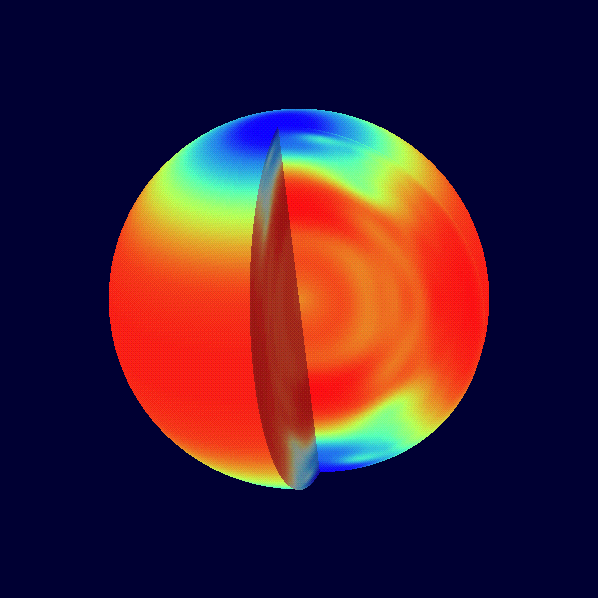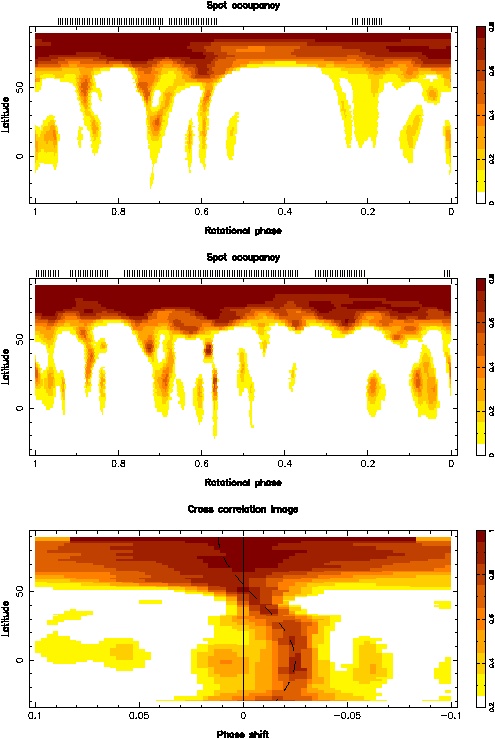

Gradients in angular rotation caused by angular momentum redistribution within the
convective layers of a cool star are expected to be one of the main ingredients for
generating the large-scale magnetic field of the Sun and
stars, through the magneto-hydrodynamical mechanisms (called
dynamo processes) that operate in their outer envelopes.
On the
Sun (see above picture where red represent faster rotation and blue slower rotation),
the study of oscillations revealed that rotation is roughly constant within
the whole radiative interior (i.e. the inner 70% of the Sun's radius) and constant with
radius (though variable with latitude) within the convective envelope (i.e. the outer
30% of the Sun's radius). The interface between these two regions is where angular
rotation gradients are strongest and thus where dynamo
processes are expected to be most efficient.
Unfortunately, the Sun is the only star yet for which internal differential rotation
is known. Till the first asteroseismology spacecrafts (such as
COROT) are
launched, Surface differential rotation (i.e. the variation
of surface rotation with latitude) remains the only information we can access on cool
stars other than the Sun.
By comparing two brightness/magnetic surface images
of a rapidly rotating spotted cool star obtained typically one week apart, one can
track the relative motion, and thus measure
the rotation rates, of starspots at different latitudes
over several rotation cycles, just as Galileo and his successors did in the particular
case of the Sun.
The two upper panels of the image below are brightness
images of the young ultra-fast rotator AB Dor (spinning more than 50 times faster
than the Sun), as reconstructed from data recorded at the 4m
Anglo-Australian Telescope on
1995 December 07 (upper panel) and
December 11 (middle panel), i.e. shifted by 8 rotation cycles. The second half of the
rotation cycle (left hand side of both images, or phase range [0.55, 0.95])) was observed
continuously at both epochs (phases of observations being depicted with vertical ticks
above each image). At first glance, the two images look remarkably similar within the
overlap phase range. A closer look reveals however that brightness features close to the
equator systematically shifted eastward (i.e. towards smaller
rotational phases) between the first and second epoch.
 © MNRAS
© MNRAS
By cross-correlating belts of equal
latitude between both images within the overlap phase range, we obtain a cross-correlation
image (lower panel) describing the amount of rotational shear as
a function of latitude at the surface of AB Dor (negative phase shifts indicating faster
rotation). The dashed curve indicates a fit to the data with a sine squared law. It tells
us that the surface rotational shear of AB Dor is very similar to
that of the Sun, both in sense (with the equator rotating faster
than the pole) and amplitude (with a time for the pole to lap the
equator by one full rotation cycle of about 120 d), even though this star rotates about
50 times faster than the Sun. Note that this is the
first reliable determination of differential rotation
(i.e. obtained with a cross-correlation analysis on two close-by Doppler images derived
from very dense data sets) in a star other than the Sun.
A small animation shows this effect on AB Dor in December 1996.
Measurements of surface differential rotation for stars with various rotation rates and
convective depths are very useful inputs to constrain hydrodynamical models of convective
zones. It should help us understand in particular how angular
momentum is redistributed within convective envelopes under the effect of convective
heat transport, anisotropic turbulence and meridional circulation. As a result, we should
obtain a better knowledge on these important (yet poorly known) basic
physical processes thought to play a major role for numerous studies in stellar
physics (such as those on dynamo field generation) and for
stellar evolution in general.
A second obvious goal is to see whether dynamo-induced magnetic fields have a
feedback action on the large-scale internal velocity fields that
produced them. Zeeman-Doppler imaging results indeed indicate
that magnetic fields seem to be produced within the bulk of the convective zones, implying
that significant magnetic to kinetic energy transfer (and thus
modification of the velocity field) probably occurs within the whole convective
envelope. Similarly, the changes in quadrupole moment that rapidly
rotating stars in
binary systems
(detected through the system orbital period fluctuations
they generate) undergo also imply significant variation of the internal velocity field.
Monitoring surface differential rotation throughout activity cycles
should bring us a definite answer to this problem. The very recent discovery that differential
rotation indeed varies with time confirms all these ideas.
 Donati J.-F. ,
``Magnetic feedback on stellar convective zones'',
in: Trujillo Bueno J., Sanchez Almeida J. (eds.),
proceedings of the Solar Polarisation Workshop #3 (2003).
ASP Conf. Series (in press).
Donati J.-F. ,
``Magnetic feedback on stellar convective zones'',
in: Trujillo Bueno J., Sanchez Almeida J. (eds.),
proceedings of the Solar Polarisation Workshop #3 (2003).
ASP Conf. Series (in press).
 Donati J.-F., Cameron A.C., Petit P.,
``Temporal fluctuations in the differential rotation
of cool active stars'' (2003) MNRAS 345, 1187
Donati J.-F., Cameron A.C., Petit P.,
``Temporal fluctuations in the differential rotation
of cool active stars'' (2003) MNRAS 345, 1187
 Donati J.-F. ,
``Surface magnetic fields and differential rotation
of solar-like stars'',
in: Arnaud J., Meunier N. (eds.),
Proceedings of the workshop dedicated to Jean-Louis Leroy on
``Magnetism and Activity of the Sun and Stars'' (2003).
EDP Sciences, EAS 9, 169
Donati J.-F. ,
``Surface magnetic fields and differential rotation
of solar-like stars'',
in: Arnaud J., Meunier N. (eds.),
Proceedings of the workshop dedicated to Jean-Louis Leroy on
``Magnetism and Activity of the Sun and Stars'' (2003).
EDP Sciences, EAS 9, 169
 Petit P., Donati J.-F., Cameron A.C.,
``Differential rotation of cool active stars:
the case of intermediate rotators'' (2002) MNRAS 334, 374
Petit P., Donati J.-F., Cameron A.C.,
``Differential rotation of cool active stars:
the case of intermediate rotators'' (2002) MNRAS 334, 374
 Cameron A.C., Donati J.-F., Semel M.,
``Stellar differential rotation from
direct starspot tracking'' (2002) MNRAS 330, 699
Cameron A.C., Donati J.-F., Semel M.,
``Stellar differential rotation from
direct starspot tracking'' (2002) MNRAS 330, 699
 Cameron A.C., Donati J.-F.,
``Doin' the twist: Secular changes in the
surface differential rotation on AB Doradus'' (2002) MNRAS 329, L23
Cameron A.C., Donati J.-F.,
``Doin' the twist: Secular changes in the
surface differential rotation on AB Doradus'' (2002) MNRAS 329, L23
 Petit P., Donati J.-F. , Wade G.A., et al.,
``Differential Rotation of Close Binary Stars:
Application to HR 1099'', in: Boffin H., Steeghs D., Cuypers J. (eds.),
AstroTomography, Indirect imaging methods in observational astronomy (2001).
Springer, Berlin, p. 232
Petit P., Donati J.-F. , Wade G.A., et al.,
``Differential Rotation of Close Binary Stars:
Application to HR 1099'', in: Boffin H., Steeghs D., Cuypers J. (eds.),
AstroTomography, Indirect imaging methods in observational astronomy (2001).
Springer, Berlin, p. 232
 Barnes J.R., Cameron A.C., James D.J., Donati J.-F.,
``''Doppler Images from dual-site observations
of southern rapidly rotating stars II: differential rotation on
Speedy Mic'' (2001) MNRAS 324, 231
Barnes J.R., Cameron A.C., James D.J., Donati J.-F.,
``''Doppler Images from dual-site observations
of southern rapidly rotating stars II: differential rotation on
Speedy Mic'' (2001) MNRAS 324, 231
 Donati J.-F., Mengel M., Carter B.D., Cameron A.C.,
Wichmann R.,
``Surface differential rotation and prominences
of the Lupus post T Tauri star RX J1508.6-4423'' (2000) MNRAS 316, 699
Donati J.-F., Mengel M., Carter B.D., Cameron A.C.,
Wichmann R.,
``Surface differential rotation and prominences
of the Lupus post T Tauri star RX J1508.6-4423'' (2000) MNRAS 316, 699
 Barnes J.R., Cameron A.C., James D.J., Donati J.-F.,
``Doppler images from dual-site observations of
southern rapidly rotating stars I: differential rotation on PZ Tel''
(2000) MNRAS 314, 162
Barnes J.R., Cameron A.C., James D.J., Donati J.-F.,
``Doppler images from dual-site observations of
southern rapidly rotating stars I: differential rotation on PZ Tel''
(2000) MNRAS 314, 162
 Donati J.-F. ,
``Surface magnetic fields of late-type stars'',
in: Butler C.J., Doyle J.G. (eds.), Brendan Byrne memorial workshop on
``Solar and Stellar Activity: Similarities and Differences'' (1999).
ASP Conf. Series, vol. 158, p. 27
Donati J.-F. ,
``Surface magnetic fields of late-type stars'',
in: Butler C.J., Doyle J.G. (eds.), Brendan Byrne memorial workshop on
``Solar and Stellar Activity: Similarities and Differences'' (1999).
ASP Conf. Series, vol. 158, p. 27
 Donati J.-F.,
``Magnetic cycles of HR 1099 and LQ Hydrae''
(1999) MNRAS 302, 457
Donati J.-F.,
``Magnetic cycles of HR 1099 and LQ Hydrae''
(1999) MNRAS 302, 457
 Donati J.-F., Cameron A.C., Hussain G.A.J., Semel M.,
``Magnetic topology and prominence patterns on
AB Doradus''
(1999) MNRAS 302, 437
Donati J.-F., Cameron A.C., Hussain G.A.J., Semel M.,
``Magnetic topology and prominence patterns on
AB Doradus''
(1999) MNRAS 302, 437
 Barnes J.R., Cameron A.C., Unruh Y.C., Donati J.-F., Hussain G.A.J.,
``Latitude distributions and lifetimes of starspots
on G dwarfs in the Alpha Persei cluster''
(1998) MNRAS 299, 904
Barnes J.R., Cameron A.C., Unruh Y.C., Donati J.-F., Hussain G.A.J.,
``Latitude distributions and lifetimes of starspots
on G dwarfs in the Alpha Persei cluster''
(1998) MNRAS 299, 904
 Donati J.-F., Cameron A.C.,
``Differential rotation and magnetic polarity patterns
on AB Doradus''
(1997) MNRAS 291, 1
Donati J.-F., Cameron A.C.,
``Differential rotation and magnetic polarity patterns
on AB Doradus''
(1997) MNRAS 291, 1